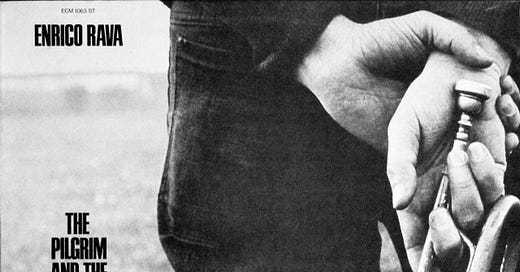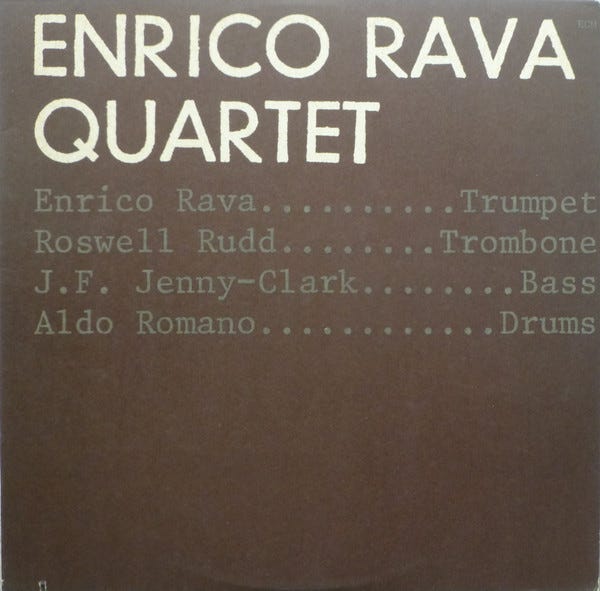Sorry to hear of the passing of the great Swedish bassist Palle Danielsson at the age of 77 earlier this week. Probably most American listeners know him best from the ECM catalog, especially the Keith Jarrett group informally called “The European Quartet” with Jan Garbarek and Jon Christensen.
As it turned out, Danielsson would end up being one of only three bassists closely associated with Jarrett. (The other two were Charlie Haden and Gary Peacock; early on, in his sideman years, Jarrett also played with Cecil McBee, Michael Henderson, Ron Carter, and a few others, including Dave Holland on the one ECM Jarrett disc as a sideman, Kenny Wheeler’s Gnu High.)
There was also a nice Peter Erskine trio with Danielsson and John Taylor that made several albums; many other projects can be found on the Danielsson Wikipedia page.
It’s been some time since I heard the first three ECM Enrico Rava LPs from the mid-’70s. I always liked them, though, and in Danielsson’s honor I thought it was time to re-listen.
The Pilgrim and the Stars (recorded June 1975)
Enrico Rava, trumpet
John Abercrombie, guitar
Palle Danielsson, bass
Jon Christensen, drums
Like many other jazz cats in 1975, Enrico Rava was thinking about how to integrate pop and rock within an improvised context. Rava is Italian, and as a composer, Rava has wonderful lyrical and somehow “Italian” sense of melody. In this high energy context with John Abercrombie, Palle Danielsson, and Jon Christensen, Rava’s shapely melodies might suggest an Italian film score by Ennio Morricone or Nino Rota.
Indeed, the charming short duo with acoustic guitar, “Parks,” would be a perfect movie cue.
Rava knows his Don Cherry as well as his Chet Baker, and on the other end of the spectrum, “Surprise Hotel” is full-out free form chaos.
“By the Sea” is a rock vamp, “Pesce Naufrago” and “Blancasnow” are space ballads, the latter with a melodic coda in tempo. John Abercrombie does some tasteful “orchestral” overdubbing in places.
It’s all great music, but the heart of the matter is on Side A with “The Pilgrim and the Stars” and “Bella.” Glamorous melodies followed by serious blowing!
Palle Danielsson, and Jon Christensen have a certain even-eighths thing, fluid and groovy. They are on record together as far back as 1968 with Steve Kuhn on Watch What Happens, helped form the ECM sound with the Garbarek-Stenson Quartet, and in 1974 landed in everyone’s consciousness with Jarrett’s Belonging.
I don’t think the New York City rhythm sections ever had to pay attention to a European rhythm section before, but the ECM albums made everyone sit up and take notice.
Christensen is coming out of Jack DeJohnette, but it’s personal and very funky, more purely pattern-oriented than DeJohnette. Danielsson is a virtuoso, but he’s not always “going for it” like Eddie Gomez or Miroslav Vitous. He’s interactive, but not too interactive, with a bass sonority that is dark and rich, closer to Charlie Haden than most of those who set up next to loud guitars and drums.
Abercrombie is a perfect wild card, he really sounds great on this album, and together everyone works up a serious head of steam on “The Pilgrim and the Stars” and “Bella.” Christensen rages below Rava and Abercrombie on “Bella.”
Wow. Fabulous record. I knew The Pilgrim and the Stars was good but didn’t remember that it was quite this good.
The Plot (recorded 1976)
Enrico Rava, trumpet
John Abercrombie, guitar
Palle Danielsson, bass
Jon Christensen, drums
A year later the same ensemble recorded again. The Plot seems to be a bit more intentionally “folkloric” than The Pilgrim and the Stars, starting with the cheerful loose vamp of “The Tribe.” (Perhaps the painting on the cover is a cue.)
“On the Red Side of the Street” and “Amaci” are both nice features for the bassist’s deep song. Danielsson was a serious artist, committed to a certain thing, recognizable in a blindfold test. Listening now, I think maybe Marc Johnson checked out some Palle Danielsson.
"Dr. Ra and Mr. Va" and “The Plot” both highlight a swinging jazz waltz with jazz chords. This is one bag that perhaps is not quite there in the rhythm section. It’s still very good (of course) but I can also hear a bit of struggle: “How do we play this style like ourselves?”
In general The Plot doesn’t quite land like The Pilgrim and the Stars.
Quartet (recorded 1978)
Enrico Rava, trumpet
Roswell Rudd, trombone
Jean-François Jenny-Clark, bass
Aldo Romano, drums
I had all three of these LPs in high school, and Quartet was the one I listened to the most. Replacing guitar with trombone immediately puts Rava’s mournful Italian melodies in high relief.
Maybe Roswell Rudd was always best as a sideman. The records with Steve Lacy, Carla Bley and Rava’s Quartet are the sonic images conjured when I think, “Roswell Rudd.” Melodic, adventurous, jazz but also not jazz.
There’s acres of space for both brass players on this LP, and they take full advantage, including lots of “comping” for each other and joyous blasts of collective improv. “Round Midnight” is a fabulous duo for the horns. I suppose this is one of the most “New Orleans” sounding of all ECM albums.
The rhythm section is good. While today I can hear that Jenny-Clark and Romano are not quite the luxury vehicle of Danielsson and Christensen, there’s also an endearing and unselfconscious clunkiness, especially from Romano. Music is a time and place, and sometimes unexpected magic appears in a studio context. For me, Enrico Rava Quartet will always be a true classic.






Agree 💯 with these appraisals. The Pilgrim and the Stars always carries with it memories of my first trip to Munich in 1975 to cover ECM and Manfred Eicher for Down Beat and the New York Times (the latter killed my piece for being too positive lol.) The first album Manfred played during a listening session of new releases was The Pilgrim and the Stars. I remember thinking that this was music, like, say, Ralph Towner’s Solstice and a few others, that could only have been created for this label. Even then, and to this day.
Curious to associate Don Cherry with utter chaos — although he could deal with that (on Ornette’s Free Jazz and with Ayler) Cherry’s free jazz usually was ( to my ears) very interested in creating form ( his “ cocktail style” suite-like sets at Cafe Montmartre, for instance, and of course Complete Communion and Symphony for Improvisers. May. I also suggest Roswell Rudd’s superb talent was as an arranger, on Archie Shell’s Impuse! albums,and particularly Numatik Swing Band with the JCOA — an album imho ripe for rediscovery.